Troubleshooting Manual
McCulloch chainsaws are designed for following forest service: limbing, felling and cutting. Chainsaws are highly dangerous equipment and if not used properly or if used when damaged they can cause very serious injuries or death. You should never use the equipment when tired or while under drugs or alcohol influence or even certain medication. Personal protective equipment should be worn at all times.
Don’t:
- ever modify the machine. Not authorized accessories or modifications can result in serious injury or death
- inhale engine’s exhaust fumes, dust or chain oil mist
- operate chainsaw without necessary safety equipment
- allow children to use or be in the vicinity of the machine
- run the engine in a badly ventilated or confined area as this can can result in death due to asphyxiation or carbon monoxide poisoning
Do:
- use common sense
- avoid all situations that you feel that those would be too much for you and your capability
- check operating procedures whenever you are not sure
- wear personal protective equipment
Following safety equipment should be used when working with McCulloch chainsaw: hearing protection, protective helmet, goggles , trousers with saw protection, gloves with saw protection, boots with saw protection. First aid kit should always be somewhere close as same as fire extinguisher.
Avoiding the kickbacks
The only and best way to avoid kickback is to ensure that the kickback zone of the bar doesn’t touch something. Most McCulloch models have kickback reduction ”built-in”, but you need to make sure that the chain is sharp and well maintained. You need to replace bar that is damaged, worn or in other instances bar together with a chain or/and chain combinations for those which are normally recommended by Husqvarna. Also the smaller the tip radius the lower the chance of kickback.
Tensioning the chain
Chains gets longer with the usage time. Every chain should be adjusted regularly to take up the slack. We advice to check and tension the chain every time you refuel. Important to mention with regards to new chainsaws is to check the chain condition more frequently than only when fueling. Chain should always be tensioned as tightly as possible, leaving only little space so that you can round it easily by using your hand (picture 11). To properly tension the chain you should follow the steps below
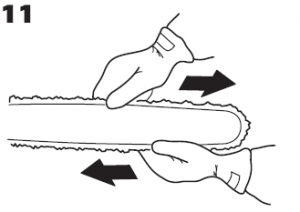
1. Switch the engine off as shown on the picture number 29
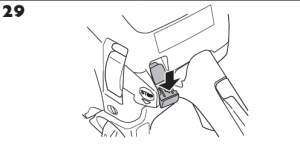
2. Release the knob by folding it out as shown on the picture 12
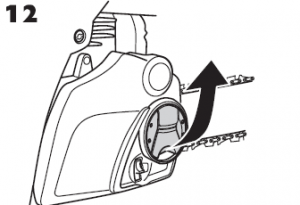
3.The knob needs to be turned anti- clockwise in. This way you will achieve the bar cover loosening- do as shown on the picture 13
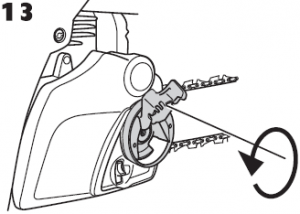
4. The chain tensioner need to be adjusted by turning the wheel up to loosen the tension and then again down in order for tightening tension
5. Lift tip of guide bar while adjusting tension as shown on the picture 14
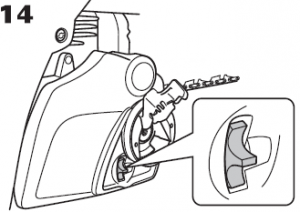
6.Tighten the clutch cover by turning the knob clockwise while lifting tip of bar. (as shown on the picture 15)
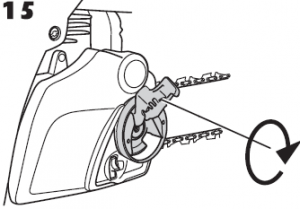
Fold the knob back in to lock the tensioning as shown on the picture 16
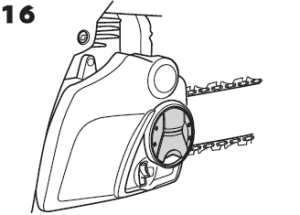
Procedure for chain oil filling
All McCulloch chainsaws have an automated chain lubrication system, however some models allow additional oil flow adjustment. In McCulloch chainsaws fuel runs out before the saw chain oil, whenever there is enough fuel and chain oil the the tanks. The carburetor is recommended: if you see that the mixture is lean- that means that the fuel lasted longer than oil. Chain lubrication should also be verified each time you refuel. The tip of the bar should be aimed at a light coloured surface around 20 cm away. 1 minute later you should run your chainsaw at 3/4 throttle and then you see light line of oil on the light surface. If that is not the case you will need to verify if there is no obstruction at the oil channel present in the bar, alternatively you will need to verify that the edge of the bar is clean. When after cleaning all mentioned before chainsaw is still not working properly you should take your equipment into the nearest McCulloch service station.
Chain drive sprocket
The spur sprocket is fitted in the clutch drum. During the everyday maintenance works you should verify if is it worn on the drive sprocket. Whenever wear is excessive it should be replaced. Other example when it always should be exhcanged is the chain replacement.
Chain replacement checks
The cutting equipment condition should be checked daily. Any signs of stiff chain, visible cracks in rivets and links, rivets and links are badly worn are immediate indication for chain replacement. Chain also always needs to be replaced when the length of the cutting teeth is lower or close to 4 mm as shown on the picture number 10
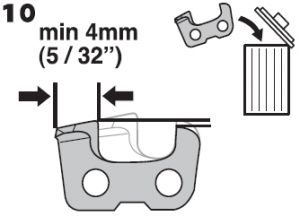
Guide bar checks
Guide bar condition should be checked regularly. Primal reason to check is to find if on the edges of the bar there are burrs (A). If you recognize those you will need to use file to remove those as shown on the picture number 17. In instances when you observe badly worn bar groove (B), the whole bar will need to be replaced as shown on the picture number 17. In instances when the bar tip is worn or uneven and a hollow forms on the tip bar underside you will need to replace not only the whole bar but also tension or/and replace the chain.
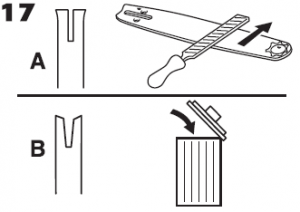
Chain and bar fitting
You should start from verifying if a chain brake is in disengaged position- moving the front hand guard towards the front handle as shown on the picture number 25
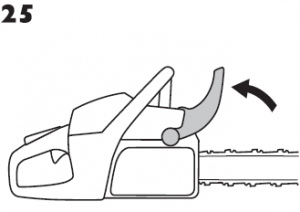
Then the knob and the chain brake should be removed too and the transportation ring should be took off as shown on the picture number 18
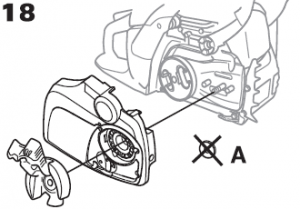
After this is completed the bar should be fitted over the bolts, put it in its rearmost position. Place the chain over the drive sprocket locate it in the groove on the bar. Start from the top edge of the bar. All the edges of the cutting links should face forward the top edge of the bar as shown on the picture number 19
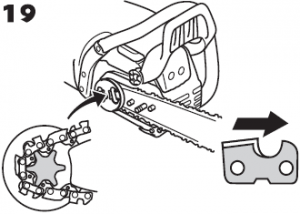
Put the chain brake over and find the chain adjuster pin, verify if all drive links of the chain fit correctly. Re-tension the chain by turning the wheel down until it does not sag from the underside of the bar as shown on the picture number 14. Hold up the bar tip and tighten the bar knob by turning the knob clockwise as shown on the picture number 15. When dealing with a completely new chain you should check it in a daily basis.
Fuel
Each McCulloch chainsaw is equipped with a two-stroke engine. Two-stroke engines run using a mixture of two-stroke oil and petrol. It is very important to accurately measure the amount of oil to be mixed, because even small differences in mixing ratio will highly affect chainsaw performance.
Table 1. Fuel mixing table applicable for all petrol McCulloch chainsaws
| Petrol, liter | Two-stroke oil, liter | Two-stroke oil, liter |
| 2% (1:50) | 3% (1:33) | |
| 5 | 0.1 | 0.15 |
| 10 | 0.2 | 0.3 |
| 15 | 0.3 | 0.45 |
| 20 | 0.4 | 0.6 |
You should always remember about mixing the petrol and oil in a clean container that is used only for this purpose. Good practice is to start with filling half of the needed amount of the petrol to be and then adding the oil. The whole mixture should be shaked carefully and only then you should pure it into the machine. Never mix more than amount needed, and before pouring in the mixture the chainsaw tank should be empty and clean. Under any circumstances don’t use waste oil as it will surely damage chain, oil pump and the bar and the chain.
Cutting equipment maintenance
Proper maintenance will long term reduce the risk or chainsaw breaking, kickbacks and will help to obtain normal performance extending your chainsaw life. Remember to always avoid increasing vibration levels. Before chainsaw usage always make sure that the cutting teeth properly sharpened, because not sharp or damaged chain highly increases the risk of accidents and life danger. Verify correct depth gauge setting and keep that chain tensioned at all times. Store the integrated combi-tool in the tool-holder when not in use, use tools recommended by producer. Following service and maintenance should be held at particular intervals. Certain works must be carried out by trained and qualified specialists at the service stations.
Table 2. Maintenance works schedule applicable for all McCulloch chainsaw models
| Maintenance works schedule | ||
| Daily maintenance | Weekly maintenance | Monthly maintenance |
| Clean the outside of the machine | Verify the starter, the starter cord and the recoil spring | Verify if chain brake band is worn,it needs replacement when at the most worn point it is lower than 0.6 mm (0,024 inch) |
| Verify throttle control components functionality: control and lockout | Verify that the vibration damping elements are not damaged | Verify the clutch spring, drum and centre, for wear |
| Clean the chain brake and Verify that it operates safely. Make sure that the chain catcher is undamaged, and replace it if needed | File off any burrs from the edges of the bar | Clean the spark plug. Verify that the electrode gap is 0.5 mm |
| The bar should be turned daily for more even wear. Verify the lubrication hole in the bar, to be sure it is not clogged. Clean the bar groove. If the bar has a sprocket tip, this should be lubricated | Clean the carburettor compartment | Clean the outside of the carburettor |
| Verify that the bar and chain are getting sufficient oil | Clean the air filter. Replace if needed | Verify the fuel filter and the fuel hose. Replace if needed |
| Verify the saw chain with regard to visible cracks in the rivets and links, whether the saw chain is stiff or whether the rivets and links are abnormally worn. Replace if needed | Empty the fuel tank and clean the inside | |
| Sharpen the chain and Verify its tension and condition. Verify the drive sprocket for excessive wear and replace if needed | Empty the oil tank and clean the inside | |
| Clean the starter units air intake. | Verify all cables and connections | |
| Verify that nuts and screws are tight. | ||
| Verify that the stop switch works correctly | ||
| Verify that there are no fuel leaks from the engine, tank or fuel lines | ||
Normal cutting technique
When cutting you should use full throttle. After each cut reduce the speed to idle, otherwise you can cause engine damage. Before you start the cutting ensure that you checked if your chainsaw won’t get stucked in the cut or strike the ground, cutting objects won’t split. Make sure you are safe. Pay special attention to kickback risk, cut in stages when needed
Types of cutting:
- splitting-cutting breaks off before the cut is complete
- from above -on the pull stroke
- limbing- cutting branches off, when limbing thick branches you should start from cutting them piece by piece. If you try to cut pile of logs, you should remove each log first and only then cut it. Once cut is done, pieces should be removed from cutting area before you start to work on another log. If you cut a log that is lying on the ground you need make sure that you don’t touch the ground as shown on the picture number 35, you can do it by making sure you cut the log from above
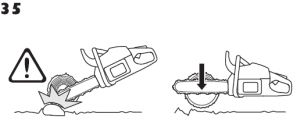
- from below-on on the push stroke- that type increases the risk of kickback, so pay special attention to how to avoid kickback section before cutting from below
Safe distance
Remember to always keep the safe distance from a tree that is to be felled and anyone or anything else. Safe distance is minimum 2 1/2 tree lengths. No work should be performed if safe zone is not really clear or safe as shown on the picture number 36
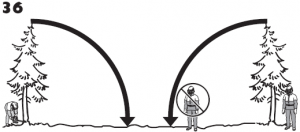
Felling direction
The tree you are cutting should always fell where you can do further cutting on it, so it should be chosen correctly before any cut happens. Once you’ve decided where it should be you must be able to judge which way the tree would fall naturally, that decision should be made on the basis of following factors: lean or bend of the tree, branches arrangement, roots damage, presence of any obstacles within the safe distance, current wind direction or weight of snow if applicable. Most common felling method is the three cuts method. You start with directional cuts- top and bottom and then you finish with the felling cut. If you do the three cuts correctly you will be able to control the felling direction.
Directional cuts
Direction cuts are to be made from the top cut. You need to be on the right side of the tree and cut on the pull stroke. Afeter you finished with top cut you need to do the bottom cut- precisely at the bottom of the top cut as shown on the picture number 38
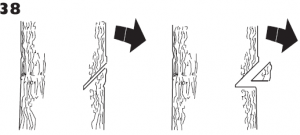
It is advised that the directional cuts run at around 1/4 of the diameter through the trunk and 45° angle.
Carburettor adjustment
The carburetor controls the engine’s speed, and it is done by throttle control. Carburetor regulates the number of motor revolutions through the accelerator. The amount of air and fuel mixture can be adjusted and good adjustment provides best performance. Basic carburetor settings are set during testing at the factory. If you want to adjust the carburetor yourself you should use the T-screw: once is turned clockwise this gives a higher idle speed and when turned anti-clockwise it gives a lower idle speed. The air and petrol mixing happens in in the carburetor, you can control this process, but air and petrol adjustment must be correct or it will significantly lower chainsaw long life. If you want to be exploit the power of the saw you should use T screw (turning it clockwise and anticlockwise as described above). When changing he carburetor setting pay attention to the moving chain, because it can result in injuries. Remember to check if cylinder is in place and air filter is clean before you start to regulate the carburetor. The minimum is properly adjusted when motor turns regularly in every position with certain margin before the chain starts turning.
Chainsaw safety equipment
Each McCulloch chainsaw has several safety options included.
Throttle lockout – it should always be locked at the idle setting when the throttle lockout is released. To ensure that the it comes back to its original position press the throttle lockout when you release it. Verify that throttle lockout and trigger move freely, check and make sure that the return springs work well. When starting the machine apply full throttle, then release the throttle control, make sure that the chain stops and remains in its position. In instances where the chain rotates when the throttle control is in the idle position you need to verify idle adjustment of carburetor
Muffler- chainsaw with faulty muffler should never be used. Before each use make sure that the muffler is securely attached. The spark arrestor screen (A) on this machine is serviceable. The mesh must be replaced if it is damaged. If the mesh is blocked the machine will overheat and this will cause damage to the cylinder and piston. You musn’t use a muffler if the spark arrestor mesh is defective or missing as shown on the picture number 7
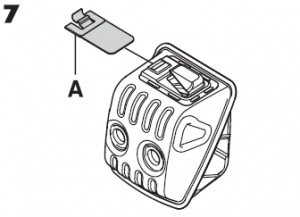
McCulloch advices to replace muffler every 75 hours of use.
Chain catcher– before using chainsaw you should always verify that the chain catcher is firmly attached to the body of the chainsaw and it is not damaged.
Vibration damping system- it needs to be check for any deformation or cracks. Although damage to the vibration damping doesn’t affects its functional use long term its disability will cause operator’s health issues and may cause safety issues if it becomes loosely attached to the engine unit and handle unit
Right hand guard- before each chainsaw usage verify that the right hand guard is not damaged. Check for any visible defects as cracks, if observed don’t use your chainsaw, but take it to the closest service shop.
Stop switch- when starting the engine you should verify that stop switch works properly as shown on the picture number 29
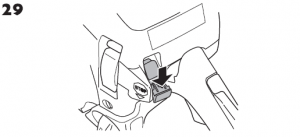
Remember that stop/start switches automatically comes back to run position. The spark plug cap must always be removed from the spark plug when the machine is unsupervised in order to avoid involuntary start up as shown on the picture number 30
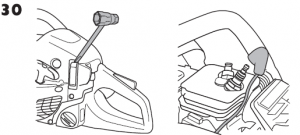
”CCS” centrifugal cleaning– air coming to the carburetor goes through the starter, where dust and dirt is centrifuged out by the cooling fan as shown on the picture number 48 CCS works only on regularly maintained machines. The air intake to the starter should be clean as well as space around the flywheel, fins on the flywheel inlet pipe and carburetor compartment
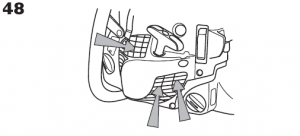
Air filter – needs to be cleaned regularly. Dirty air filter will result in carburetor malfunctions and will cause such problems as: loss of engine power, starting problems, excessive fuel consumption and finally wear to engine parts. To replace dirty air filer taking off the cover, re-fitt making sure that everything is sealing tightly to the holder. Filter can also be cleaned by shaking, brushing as shown on the picture number 44 or by washing it in water with soap. If you use the same air filter for more than a year you should replace it, not clean it
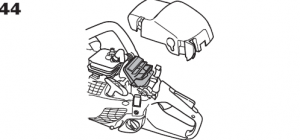
Spark plug- in instances when your chainsaw is doesn’t want to start, low on power, or doesn’t run well at idle speed you should start from verifying the spark plug condition first. The spark plug condition depends from: dirty air filter, wrong fuel mixture (incorrect type of oil or too much of it), incorrect carburetor adjustment. All mentioned result in deposits on the spark plug electrodes. Clean the spark plug when it is dirty, remember that the electrode gap should be around 0,5 mm. McCulloch recommends to replace spark plug should after a month of usage. When replacing spark plug always use spark plug designed for your model only, using of not supported plug will result in piston/cylinder damage.
McCulloch winter use
When using your chainsaw during the winter you can experience following issues: Icing of the air filter and carburetor and too low engine temperature. To avoid those you need to partly cover the air inlet on the starter and that will allow to rise engine temperature, you can also purchase special winter cover that is mounted on the starter housing. Cover should be used only during the winter conditions and then needs to be removed because it will cause overheating the engine and will damage it.